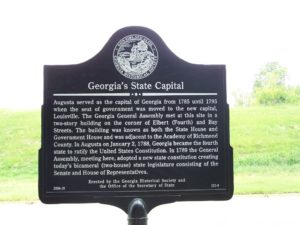September brings the beginning of another school year and the beginning of the Georgia History Festival. The Georgia History Festival is the signature K-12 educational program of the Georgia Historical Society. This year, the Georgia History Festival theme is “Ensuring Liberty and Justice for All.” For the month of September, #MarkerMondays will focus on the ratification of the United States Constitution and the Georgians who played a role in the history of creating the document.
This week’s #MarkerMonday highlights the Georgia Constitutional Convention of 1788. Between May and September 1787, delegates from the thirteen states of the United States met in Philadelphia, Pennsylvania, with the intent to revise the Articles of Confederation. The Articles created a loose confederation of sovereign states and a weak central government, leaving most of the power with state governments. The need for a stronger federal government soon became apparent, given its lack of power to handle and enforce domestic and foreign policy matters. The result of what is now known as the Constitutional Convention was the creation of the United States Constitution, establishing a federal government with more specific powers, including those related to foreign affairs. The new constitution signed by 39 of the 55 delegates attending the convention was sent to the states to be ratified in September 1787. At this time, Augusta served as the capital of Georgia. The Georgia General Assembly, the state’s legislative body, called for a special convention to ratify the Constitution. The special convention consisted of 26 delegates representing Georgia’s 11 counties. Meeting in late December 1787, the delegates voted unanimously to approve the Constitution two days after the initial meeting. On January 2, 1788, the delegates signed the Georgia Ordinance Ratifying the United States Constitution, making Georgia the fourth state to ratify the Constitution. Georgians had several reasons to support the ratification of a new constitution. Georgia’s lawmakers and farmers hoped that a stronger central government would assist the state in its negotiations with the Creek Nation, which claimed large portions of Georgia as part of its land. Along the coast, Georgians thought that a strong central government would be beneficial to regulate trade. The ratification of a new federal constitution also led to a revision of the state’s constitution the following year.
United States Constitution draft annotated by Abraham Baldwin, 1787. Georgia Historical Society, MS 1703.
Explore the links below to learn more about the Georgia Constitutional Convention of 1788.
GHS is proud to house Abraham Baldwin’s Draft Copy of the U.S. Constitution in the Georgia Historical Society Image Catalog.
GHS’ Education Blog, Sophia’s Schoolhouse, has created a series of videos to relating to the United States Constitution and Constitution Day. A complete Episode Guide of all videos can be viewed on the Sophia’s Schoolhouse blog.
- Episode 17: Top Ten Reasons to Study the US Constitution
- Episode 18: Get to Know Abraham Baldwin
- Episode 19: Understanding the Constitutional Convention
- Episode 20: Georgians React to the Constitution
New Georgia Encyclopedia (Constitutional Convention)
New Georgia Encyclopedia (Georgia Constitution)
Department of State- Office of the Historian: Constitutional Convention and Ratification, 1787-1789
Department of State- Office of the Historian: Articles of Confederation, 1777-1781
Encyclopedia Britannica: Constitutional Convention (1787)
National Archives: Meet the Framers of the Constitution
Georgia Info: Georgia Ordinance Ratifying the U.S. Constitution, 1788 (transcript)
Further Reading
Related #MarkerMonday Posts
Summer Home of Joseph Habersham (Posted September 3, 2018)

